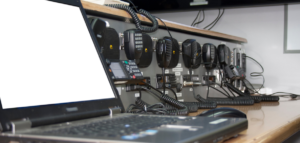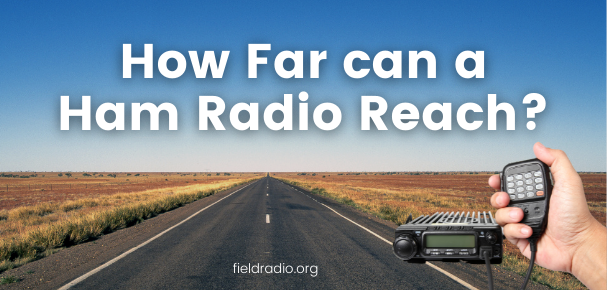If you are a ham radio operator or are thinking about getting your amateur radio license, then there must be one piece of hardware in your shack – the radio itself.
But though radios may come in many different shapes and sizes, they all have one thing in common: They need power! So what do you need if you want to connect your rig to AC power? The answer to that question is “a laptop.”
Why Do You Need a Laptop?
For most hams these days, it’s almost essential that they get a laptop computer. Why not just get a desktop machine? For portable operation at an Amateur Radio Field Day Event, for example. Or when camping out with the family at summer camp. Having a laptop could make the difference between having fun and sitting in the car with the engine off.
However, it’s not very easy to choose a laptop for ham radio use. There are many things that ham operators will want their laptops to do, but there are trade-offs between portability, cost, performance, and features when you’re looking at laptops. And most of us don’t have unlimited budgets to spend on laptop computers.
So let’s see if we can help you make this decision by examining what makes a good machine for someone who wants to operate amateur radio from it – or even remotely control your Amateur Radio station!
What to Look for in a Laptop?
To begin with, let me tell you what I think is essential when choosing the best laptop for ham radio use:
- Easy access/connection points for antenna, power, Ethernet, and USB cables.
- A laptop that is rugged enough to take the bumps of being used in mobile/portable situations.
- Good battery life (preferably with an external spare battery pack). If you are going to be away from mains power for more than a few hours at a time, then your laptop will need some backup power source. There’s nothing worse than watching the battery power slowly drain away while you’re trying to figure out what’s wrong with your radio!
- A laptop that has good available support. When it comes time to do something specific or research questions about computer control of your radio – then having an easy-to-use reference manual on hand can help.
- A laptop that has a “reasonable” price. With the number and type of laptops available today, it’s possible to find something for just about any budget – or not!
Supports Digital Signal Processing
Once you have decided what your budget is, you’ll need to look at some features. We want to get as much power as we can out of our radios, so they must support Digital Signal Processing (DSP). It doesn’t matter too much if your radio does not have internal DSP processing.
You can still operate remote control with external signal processing boxes. But it will be impossible to go beyond half-duplex operation without an internal DSP card in your ham laptop machine. Yet another reason why I prefer PC’s over Macs for ham radio use.

Operating System
Just as a thought to keep in mind – you don’t want a laptop running on discontinued Windows Operating Systems such as Windows XP. It does have some limitations regarding the number of simultaneous connections that can be made and how many serial ports will be available.
I would suggest at least a 64-bit version of Windows 10 (Professional). That way, you’ll have sufficient system resources to run everything smoothly and still have lots of room left over for other Internet activities like web surfing, emailing, and playing games.
However, if your budget is tight enough, you could consider buying an older (and cheaper) laptop that only runs Windows XP Professional. That might not give you access to some of the latest software, but it will run everything necessary for controlling Amateur Radio equipment.
There’s no point in even considering a laptop with any version of Apple macOS on it. For ham radio applications at least, they do not compare favorably against Windows-based computers.
You can’t use Remotehams or Echolink without virtualization (running Windows and Linux under the MacOS), and that would be about the only reason we would go with an Apple computer.
Recommended Connectivity
I strongly recommend connecting to the PC via Ethernet rather than USB to get your data on and off your radio. The speeds are much higher, and you won’t have to worry about having your radio and computer connected at the same time.
You’ll need a laptop with a minimum of two serial ports. The best would be four, but I don’t know of any laptops that have a total of more than three (two for COM1/COM2 plus one spare).
Generally speaking, you can get by quite well with just two connections. But when the need arises where you need to connect to more than one remote device at once, then you might want to consider getting a USB-to-serial port adapter.
If you’re lucky enough to own an HF transceiver that’s capable of full crossband operation, then it will be necessary to connect two radios at once! I’m not aware of any hams who own this type of radio – so if you do, then count yourself as one of the lucky few!
Sound Card
Besides supporting DSP hardware within your laptop, having at least a 96kHz sample rate on all channels is also essential. This will ensure you can receive signals at their native frequencies (7MHz, 14MHz, and 28MHz).
If your sound card does not support 96kHz sampling rates, the only other option is to use external USB or Firewire dongles that support this higher sampling rate.
Memory
The last thing I’ll mention here is memory. A minimum of 2GB should be enough for most ham applications today – but more is always better if possible. If you’re using Maestro for logging, then it might be best to use the 32-bit version (so more memory is addressable by your system).
My recommendation would be this – figure out how much money you can afford to spend on this project, and get the most computer with the most features you can. Yes, I know that’s not very helpful, but in general, it’s hard to go wrong with any modern laptop made in the last few years.
The only exception is if you plan on doing video editing or anything else that will require a high-performance graphics processor. And even in that case, it’s still worth getting at least an Intel Core i5 processor over one of the older models that don’t support Hyperthreading.
Best Ham Radio Laptop – Our Pick
The Dell Inspiron 15R (ebay) is an excellent example of a laptop I would recommend for Amateur Radio applications.
If your budget can be stretched, then consider looking at the XPS13 (ebay) or XPS15 (ebay) instead. They have a better screen and a faster graphics processor to give you a slightly better user experience in some cases. But they also cost significantly more money!

I have been passionate about the world of communications in its various forms for most of my life. Ever since I first found an old ham radio stashed away in my uncle’s attic, I have had a fascination with this classic technology.
Having the ability to communicate with people without the need to rely on telephone lines or networks is an empowering feeling which I believe everyone should have at least a basic knowledge of. Becuase who knows when you might need it?
I setup fieldradio.org with this passion in mind, to help inform people about the amazing possibilities of amateur radio and I’m on a quest to help educate as many budding operators as possible.
I hope you enjoy our content. Come and say hi, via our contact form



